
The Amiga 500, also known as the A500, is the first low-end version of the Amiga home computer. It contains the same Motorola 68000 as the Amiga 1000, as well as the same graphics and sound coprocessors, but is in a smaller case similar to that of the Commodore 128.

Populous is a video game developed by Bullfrog Productions and published by Electronic Arts, released originally for the Amiga in 1989, and is regarded by many as the first God game. With over four million copies sold, Populous is one of the best-selling PC games of all time.

The Apple IIe Card is a hardware emulation board, also referred to as compatibility card, which allows compatible Macintosh computers to run software designed for the Apple II series of computers. Released in March 1991 for use with the LC family, Apple targeted the card at its widely dominated educational market to ease the transition from Apple II-based classrooms, with thousands of entrenched educational software titles, to Macintosh-based classrooms.

UAE is a computer emulator which emulates the hardware of Commodore International's Amiga range of computers. Released under the GNU General Public License, UAE is free software.

Pool of Radiance is a role-playing video game developed and published by Strategic Simulations, Inc (SSI) in 1988. It was the first adaptation of TSR's Advanced Dungeons & Dragons (AD&D) fantasy role-playing game for home computers, becoming the first episode in a four-part series of D&D computer adventure games. The other games in the "Gold Box" series used the game engine pioneered in Pool of Radiance, as did later D&D titles such as the Neverwinter Nights online game. Pool of Radiance takes place in the Forgotten Realms fantasy setting, with the action centered in and around the port city of Phlan.

The Macintosh II is a personal computer designed, manufactured, and sold by Apple Computer from March 1987 to January 1990. Based on the Motorola 68020 32-bit CPU, it is the first Macintosh supporting color graphics. When introduced, a basic system with monitor and 20 MB hard drive cost US$5,498. With a 13-inch color monitor and 8-bit display card the price was around US$7,145. This placed it in competition with workstations from Silicon Graphics, Sun Microsystems, and Hewlett-Packard.
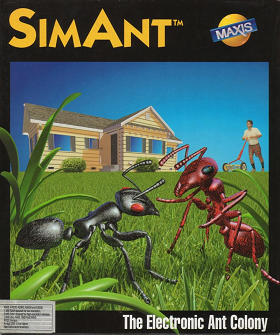
SimAnt: The Electronic Ant Colony is a 1991 life simulation video game by Maxis and the company's third product, focusing on ants. It was designed by Will Wright. In 1992, it was named "Best Simulation Game" at the Software Publishers Association's Codie awards. SimAnt was re-released in 1993 as part of the SimClassics Volume 1 compilation alongside SimCity Classic and SimLife for PC, Mac and Amiga. In 1996, SimAnt, alongside several of Maxis' simulation games were re-released under the Maxis Collector Series with greater compatibility with Windows 95 and differing box art, including the addition of Classics beneath the title.
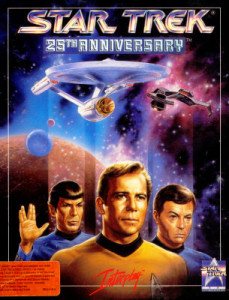
Star Trek: 25th Anniversary is an adventure video game developed and published by Interplay Productions in 1992, based on the Star Trek universe. The game chronicles various missions of James T. Kirk and his crew of the USS Enterprise. Its 1993 sequel, Star Trek: Judgment Rites, continues and concludes this two-game series.
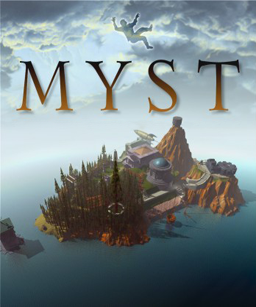
Myst is a graphic adventure designed by the Miller brothers, Robyn and Rand. It was developed by Cyan, Inc., published by Broderbund, and initially released in 1993 for the Macintosh. In the game, the player travels via a special book to a mysterious island called Myst. From there, solving puzzles allows the player to travel to other worlds ("Ages"), which reveal the backstory of the game's characters and help the player make the choice of whom to aid. The player interacts with objects and walks to different locations by clicking on pre-rendered imagery.
The Adventure Game Interpreter (AGI) is a game engine developed by Sierra On-Line. The company originally developed the engine for King's Quest (1984), an adventure game which Sierra and IBM wished to market in order to attract consumers to IBM's lower-cost home computer, the IBM PCjr.

The Fool's Errand is a 1987 computer game by Cliff Johnson. It is a meta-puzzle game with storytelling, visual puzzles, and a cryptic treasure map. It is the tale of a wandering Fool who seeks his fortune in the Land of Tarot and braves the enchantments of the High Priestess. A sequel titled The Fool and His Money was released October 25, 2012.
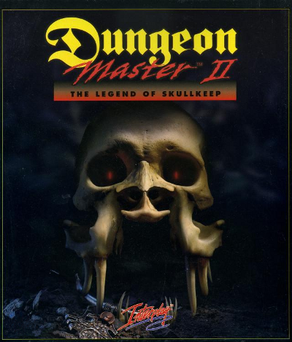
Dungeon Master II: The Legend of Skullkeep, also released as Dungeon Master II: Skullkeep, is the sequel to the dungeon crawler role-playing video game Dungeon Master. It was released in 1993 in Japan and in 1995 in other countries. It is available for DOS, Amiga, Macintosh, Sega CD, PC-9801, PC-9821, and FM Towns. A Sega Mega Drive version was planned but never released.

It Came from the Desert is a 1989 action-adventure game by Cinemaware. It was originally released for the Amiga, but later ported to MS-DOS, as well as released in distinctly different forms to consoles. The TurboGrafx-16 release is distinctly different from the computer versions, in terms of gameplay and presentation. An expansion set Antheads: It Came from the Desert II was released in 1990.

The King of Chicago is a 1986 action-adventure video game by Doug Sharp. Based on numerous Hollywood mobster movies, this game is set in the 1930s, but some sequences towards the end of the game take place in 1986. The Macintosh version of the game is animated using claymation, while other versions utilize drawn graphics.

The Faery Tale Adventure is a 1987 action role-playing video game designed by David Joiner and published by MicroIllusions for the Amiga, and later ported to the Commodore 64, MS-DOS, and Sega Genesis. The MS-DOS version is titled The Faery Tale Adventure: Book I. Microillusions also released a "Book 1" version for the Amiga which was going to be the start of a series of games, according to Talin, but bankruptcy prevented it. The initial version was produced for the Amiga 1000 and featured the largest game world to that date. A sequel, Faery Tale Adventure II: Halls of the Dead, was released in 1997.

Leisure Suit Larry in the Land of the Lounge Lizards is a graphic adventure game, developed by Sierra On-Line, and published in 1987. It was developed for the PC, DOS, and the Apple II and later ported to other platforms, such as the Amiga, Atari ST, Apple IIGS, Macintosh, and Tandy Color Computer 3. It utilizes the Adventure Game Interpreter (AGI) engine. In 1991, Sierra released a remake titled Leisure Suit Larry 1: In the Land of the Lounge Lizards for PC DOS, Apple Macintosh, and Amiga. This version used the Sierra's Creative Interpreter (SCI) engine, featuring 256 colors and a point-and-click, icon-driven user interface.
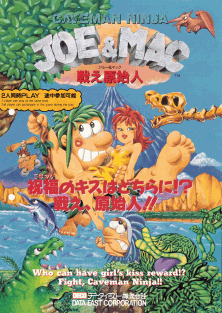
Joe & Mac, also known as Caveman Ninja and Caveman Ninja: Joe & Mac, is a 1991 platform game released for arcades by Data East. It was later adapted for the Super NES, Mega Drive/Genesis, Nintendo Entertainment System, Game Boy, Amiga, Zeebo, Nintendo Switch, and PC.
Amiga software is computer software engineered to run on the Amiga personal computer. Amiga software covers many applications, including productivity, digital art, games, commercial, freeware and hobbyist products. The market was active in the late 1980s and early 1990s but then dwindled. Most Amiga products were originally created directly for the Amiga computer, and were not ported from other platforms.

Space Quest III: The Pirates of Pestulon is a 1989 graphic adventure game by Sierra On-Line, and the third game in the Space Quest series.
Pool of Radiance is a series of role-playing video games set in the Forgotten Realms campaign settings of Dungeons & Dragons; it was the first Dungeons & Dragons video game series to be based on the Advanced Dungeons & Dragons rules.

















